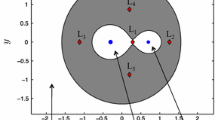Abstract
A wide variety of equal-mass stellar triple systems has been numerically integrated in order to establish factors pertinent to stability. The significant parameters appear to be whether the relative revolution is direct or retrograde, and the ratio of the periastron distance in the outer orbit to the semi-major axis of the inner orbit. For stability, this ratio must be at least 3.5 for direct orbits and at least 2.75 for retrograde orbits.
Similar content being viewed by others
References
Evans, D. S.: 1968,Quart. J. Roy. Astron. Soc. 9, 388.
Finsen, W. S. and Worley, C. E.: 1970,Union Obs. Circ. 7, No. 129.
Harrington, R. S.: 1968,Astron. J. 73, 190.
Harrington, R. S.: 1969,Celes. Mech. 1, 200.
Harrington, R. S.: 1970,Astron. J. 75, 1140.
Sharpless, S.: 1966,Vistas in Astronomy 8, Pergamon Press, Oxford, p. 127.
Szebehely, V.: 1971,Celes. Mech. 4, 116.
Author information
Authors and Affiliations
Rights and permissions
About this article
Cite this article
Harrington, R.S. Stability criteria for triple stars. Celestial Mechanics 6, 322–327 (1972). https://doi.org/10.1007/BF01231475
Received:
Issue Date:
DOI: https://doi.org/10.1007/BF01231475




